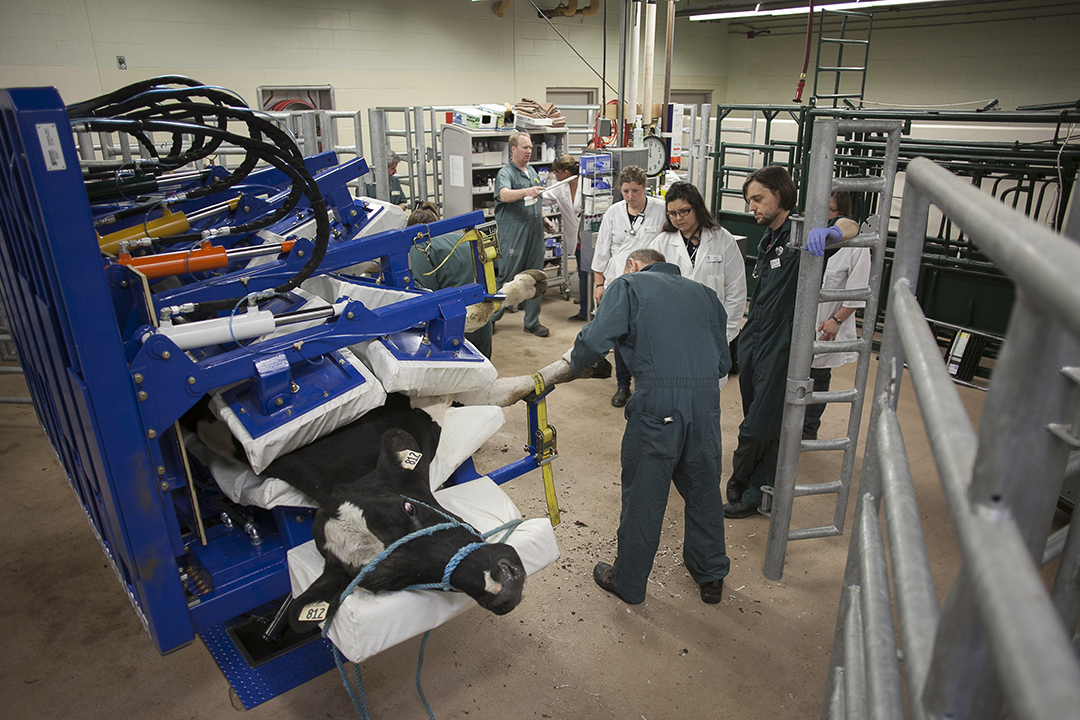
Unique table tilts cows' world
It's October and veterinarian Dr. Chris Clark is looking forward to tipping cows again. But he's not planning any Hallowe'en pranks. The associate professor at the Western College of Veterinary Medicine (WCVM) is talking about regaining the use of the tilt table — a highly efficient piece of equipment that was recently refurbished and re-installed in the WCVM Veterinary Medical Centre's Large Animal Clinic.
By Lynne Gunville
The hydraulic tilt table is an indispensable tool that's primarily used for bovine hoof treatment and trimming. Over the years, many of Western Canada's top show cattle have taken a ride on the unique tilt table for their regular "bovine pedicures."
The table is also invaluable for examining and treating injuries and problems with a bull's genitals or a cow's udders.
"Using the table is much safer and easier than trying to get underneath to examine the animal," says Clark, who specializes in large animal internal medicine. "It provides us with an optimal environment for doing a thorough examination and preparing the site if you have to do some suturing."
While the WCVM's recently installed table may appear new, it's actually an updated version of the device that was developed in the mid-1970s by Arnie Brockman, an engineering consultant from Humboldt, Sask. With advice from veterinarian Dr. Jim Sawatsky, he built two tables — one for Sawatsky's veterinary clinic in Foam Lake and one for the WCVM.
The original design allows a cow to walk in between the two sides of the table which can accommodate animals ranging in size from calves to bulls weighing over 3,000 pounds.
Once the cow is in the right position, the device grips the animal from above and the pressure of the airbag lining is adjusted to hold it. Then a hydraulic drive lifts the animal off its feet and smoothly flips it onto its side so it's lying on the table.
"Cows tend to give up once they're confined," Clark explains. "So once they're in the squeeze, they stop struggling and are actually quite calm while they're in the device."
After veterinarians finish a procedure, the table returns to an upright position so the cow ends up back on its feet.
After 40 years of regular use with few technical issues, the original tilt table had to be retired in 2013 when it started showing signs of mechanical problems.
Clark and other WCVM large animal clinicians had to resort to an old-fashioned system of ropes and pulleys for examining and treating any hoof issues. The system posed a greater risk of damage to both the clinicians and the animals.
The University of Saskatchewan began its search for an engineering company that would take on the job of reconditioning the equipment and making some upgrades — improvements to the design that were now possible because of modern technology.
The successful firm was RMD Engineering, a Saskatchewan company that has worked on other university projects.
"They saw it as a real challenge and had fun working with it," says Clark. "They did an incredible job of adapting the table."
Clark is relieved to have the table back, not only because he's tired of visiting his chiropractor but also because it speeds up learning for the college's veterinary students. With the table exposing all four feet at once, four students can work on a cow while it's lying quite comfortably.
"It's a great teaching tool, and it's amazing to see the tilt table back in action," says Clark.
